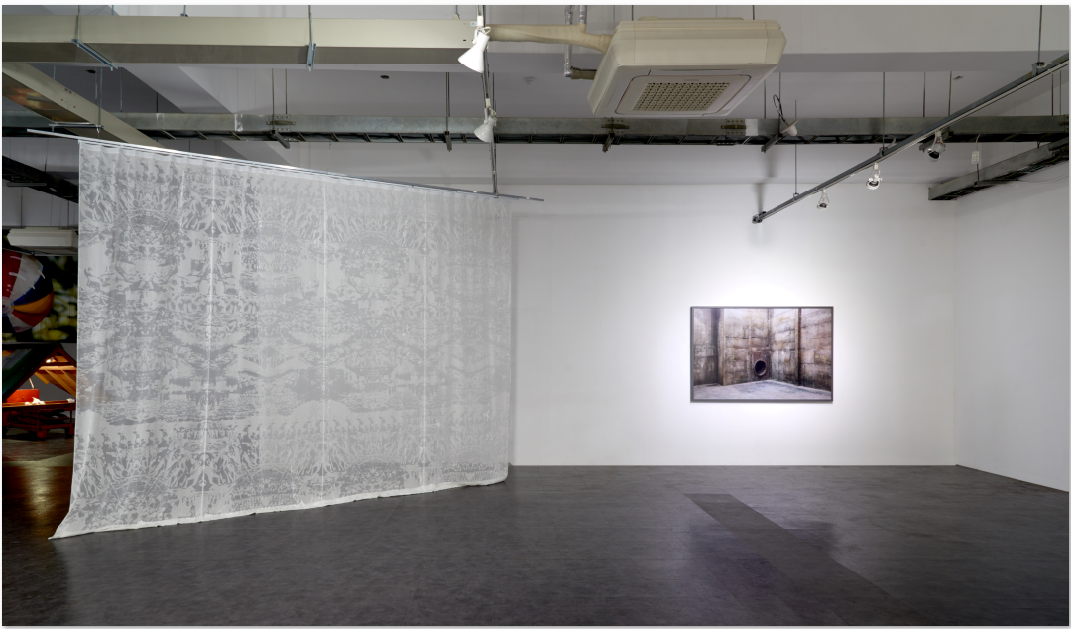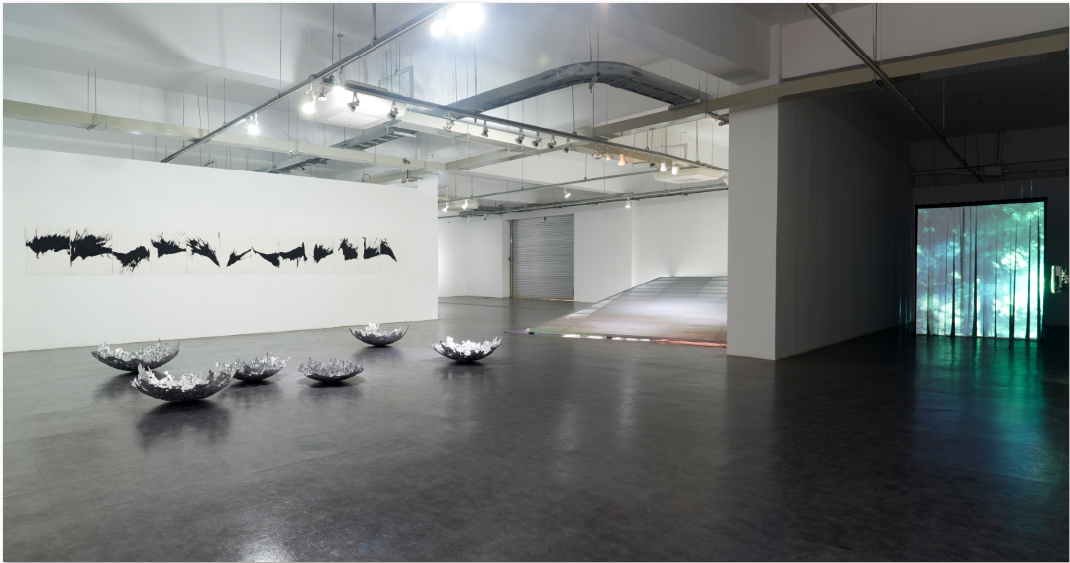
Overlapped Sensibility: Imbued
Mixed media, Installation variable, 2017
MIN SUNG HONG focuses on experience facing unfamiliar environments, an invisible relationship in execution, and inner conflicts and emotional changes from experiences in cultural difference. The collected roofs from Daebudo show abandoned empty spaces from migration implicitly. They are placed with photographic records of layered bird-head shapes, produced by the slip casting method. The roofs are closely related to the local surroundings to adapt to the environment. It acts as a symbolic space borrowed from the miniaturized frame of life.
 Veil II
Veil II Velvet, Curtain Rail, 320(h)x442(w)cm, 2017
Veil II looks generally white and like a fancy lace curtain but if you have a closer look, it is an image created by collecting and editing images containing scenes of a mass massacre and by burning away negative images on a white velvet fabric with the burn-out method. It displays the truth of a concealed past that is difficult to grasp without a careful and active interest and the current state of institutionalized passiveness towards them.
 Tide Time
Tide TimeMixed media, Installation variable, 2017
Daebudo is no longer an island after a connection with the land by the construction of the Shiwha seawall. Deabudo, where fishing used to be the major occupation, no longer has the water serving as its main industry. Its identity has also changed. The memory of the island is also fading away. By starting to call for fading languages of the island, tide time : Sari, Jogeum, Moosi, etc., the work questions the identity of Daebudo and starts to recall the memory of the island.
 Klein’s bottle
Klein’s bottlePigment print, 120(h)x180(w)cm, 2017
Many instant changes coming from the process of blind growth and modernization lose their distinct identity without the essence inside. The current state experiencing sporadic standardized urbanization is hard to be recognized as if they are real or artificial and like the Klein’s bottle that has ambiguous inner and outer space.
 An island became an hill under the moon, the hill dreaming of the island : from the parallax between the rising tide and ebb tide
An island became an hill under the moon, the hill dreaming of the island : from the parallax between the rising tide and ebb tideMixed media, Installation variable, , 2017
LEE SUJIN focuses her interest on the geographical condition of tide time and represents the island as a huge living thing with a continuous cycle of extinction and formation. The work reflects imagination of the moment of the falling and rising of the sea on the other side of the Earth, where it is symmetrical to gravitational forces of the Sun and the Moon. It discovers abandoned and discarded objects that exhausted their functions during the practice of archeology of matters between the sea and the moon.
 Instant
InstantPigment on paper, Polyptyque , 2017
Drop
Aluminum, Installation variable, 2017
Small and large island sprayed on the west coast of Gyeonggi province has often calm or tough sea and wind. Yoon-hee focuses on the flow of the sea coming in various forms every moment. The artist visually reproduces momentary phenomena and the unseen physical potential of an object and shows its ways of the existence.
 A Blue Haze
A Blue HazeMixed media, Video installation, 2017
‘A Blue Haze’ expresses interconnected relationships of elements such as free movement without a definite object, ambiguous time boundary from the interference of many moments, and the re-establishment of space boundary based on movements to escape or return to its original position in a visual video. Irregular regulations captured from the movement of trees by wind was imaged and overlapped with the artist’s drawing. The overlapped two layers interfere with each other and erase, fade, emerge, and cross continuously.
 Bitter ideals and dawn
Bitter ideals and dawn300(h)x260(w)cm, Acrylic on canvas, 2017
Bul-Do (written by Choi Yoonjung, curator)
Novel, Installation on the wall, 2017
Bul-Do, which is one of the islands in the coast of Gyeonggi province is currently included in Daebudo and is forgotten to people except for its geographical characteristics. Jeon Heekyoung illustrates an imaginary story with fantasy using a few related vocabularies to the island.
 A Song of Daebudo
A Song of DaebudoPhotograph, Installation variable, 2017
‘A Song of Daebudo’ is a series of ‘A Song of Korea’ tracing an intrinsic image of environment and nature in Korea. It mildly displays life and landscape of the coastal area of Gyeonggi province that has faded away with traces of modernization.
 A Portrait of Our Times
A Portrait of Our TimesMixed media, Video Installation, 2017
The story of bay salt in the coastal area of Gyeonggi province is a history of colonial exploitation in the Japanese colonial era. Afterwards, Gunja and Sorae salt ponds, developed in the coastal area of Shiheung and Incheon, produced more than half of the total salt production amount in Korea but the history of these salt ponds started to fade away in the mid-1990s. However, in another side of the life journey during the industrialization and urbanization, memories kept by a father of a family and by a hardworking worker in a salt pond, are now aged over 70 to 80 years. The portrait that recalls stories of the workers melted under the hot sun does not only remind of an individual in an area but extends to history and short stories of our lives. In addition, it approaches to us by reflecting our lives in current days.
















